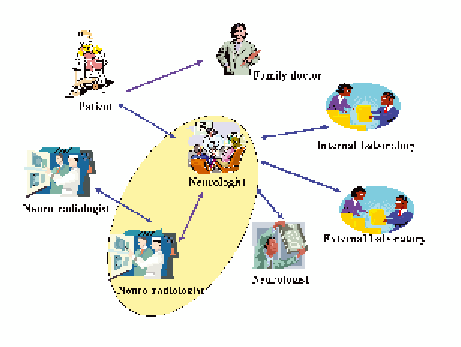Information Technology Reference
In-Depth Information
During the field study, the analysts periodi-
cally observed the physicians during their daily
work in the hospital (about two to three visits per
month since 2003). They observed meetings of
physicians of the same departments and meet-
ings of physicians with different specialization.
Sometimes, they performed semistructured
interviews for better understanding documents,
tools, and languages. The information collected
during the study has been used to identify the
right requirements of the application.
The stakeholders identified through the field
study are the neurologist; neuroradiologist; patient
(the child with neurological troubles and her or
his family); family doctor (knows the symptom-
atology of the patient and prepares a diagnostic
question for the neurologist); internal laboratory
(performs the examinations prescribed by the
neurologist and is sited in the hospital in which
the neurologist works); and external laboratory
(performs examinations but is outside the hospital
in which the neurologist works).
Usually, a patient with troubles first goes to her
or his family doctor. The doctor suggests to the
patient family to go to a neurologist and prepares
a diagnostic question for the patient. The neurolo-
gist studies the symptomatology of the patient
and prescribes others medical analyses that can
be performed in the internal laboratory, such as
EEG (electroencephalogram), or in the external
laboratory, such as blood test, magentic resonance
image (MRI) and so on. When the neurologist has
the analysis results of the patient, the neurolo-
gist studies them accurately and often identifies
critical results and makes some annotations on
them. Then, the neurologist defines a diagnosis
and gives it to the patient or the patient's family.
In particularly serious and difficult cases, before
formulating a diagnosis, the neurologist needs to
ask other physicians for a consultation to better
reason through the pathology of the patient. For
example, the neurologist can decide to refer to
a neuroradiologist for a more detailed analysis
through MRI. The neuroradiologist provides an
opinion to the neurologist. Both neurologist and
neuroradiologist can also ask for a consultation to
another colleague, neurologist, or neuroradiologist
respectively, specialized in particular pathologies.
At the end of the consultations, the neurologist
gives the diagnosis and the treatment to the patient.
The information flow just described is represented
in Figure 2, where the interaction among neurolo-
gists and neuroradiologists is highlighted, the one
we investigated in this chapter.
Figure 2. The information flow: The interaction among neurologist and neuroradiologist is that one
investigated in the chapter

Search WWH ::

Custom Search